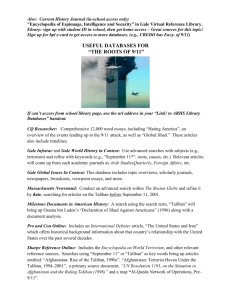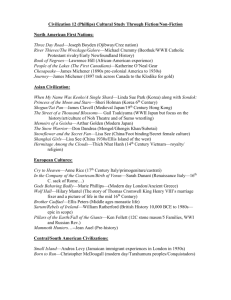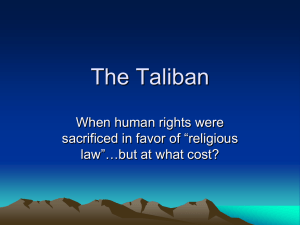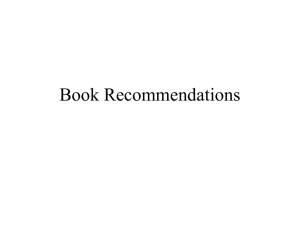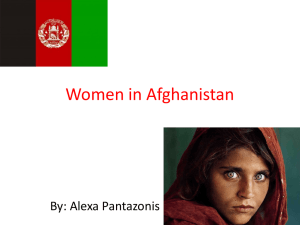In the Shadows and Behind the Veil
advertisement
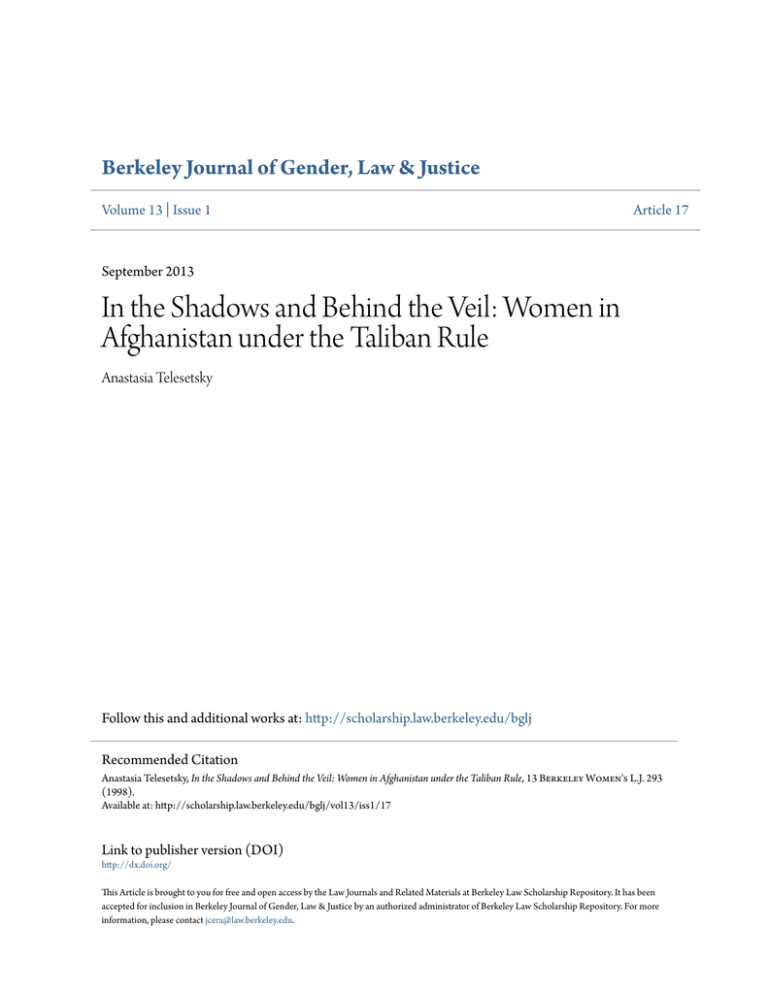
Berkeley Journal of Gender, Law & Justice Volume 13 | Issue 1 Article 17 September 2013 In the Shadows and Behind the Veil: Women in Afghanistan under the Taliban Rule Anastasia Telesetsky Follow this and additional works at: http://scholarship.law.berkeley.edu/bglj Recommended Citation Anastasia Telesetsky, In the Shadows and Behind the Veil: Women in Afghanistan under the Taliban Rule, 13 Berkeley Women's L.J. 293 (1998). Available at: http://scholarship.law.berkeley.edu/bglj/vol13/iss1/17 Link to publisher version (DOI) http://dx.doi.org/ This Article is brought to you for free and open access by the Law Journals and Related Materials at Berkeley Law Scholarship Repository. It has been accepted for inclusion in Berkeley Journal of Gender, Law & Justice by an authorized administrator of Berkeley Law Scholarship Repository. For more information, please contact jcera@law.berkeley.edu. In the Shadows and Behind the Veil: Women in Afghanistan Under Taliban Rule Anastasia Telesetskyt INTRODUCTION Women need not read the classified ads in Kabul, Heart, and other Taliban-dominated areas in Afghanistan. No one will employ them since the Taliban issued directives in late September 1996, forbidding women from employment outside of the home.' Civil servants, teachers, bakers, and charwomen' are still awaiting the salaries promised to them by the Taliban if they would remain at home outside of the public eye.3 This is a shocking financial blow for Afghan women because they represent nearly sixty-five to seventy-five percent of the Afghan population due to the numerous male casualties during the decades of the civil war and Soviet occupation.4 Bans on white socks, shoes that squeak, and ankles showing are all decrees in the brave new world that marks Afghanistan under the Taliban's moral code as enforced by the Ministry of Vice and Promotion of Virtue.5 Women move about like shadows in their head-to-foot nylon coverings and walk softly in slippers so as not to distract or excite men.6 Woe to those who challenge nationwide edicts regarding Islamic propriety. Since the rise of the Taliban to prominence in 1994,' Amnesty Copyright 0 1998, BERKELEY WoMEN's LAW JoURNAL. J.D. cand., Boalt Hall School of Law, University of California at Berkeley. 1. See U.S. Department of State, Afghanistan Report on Human Rights Practicesfor 1996 (Jan. 30, 1998) <http://www.state.gov/www/global/human-rights/1996_hrpreportafghanis.html>. 2. A charwoman is a cleaning woman. 3. See U.S. Department of State, supra note 1. 4. See Feminist Majority Report, Will Women Be Sacrificedfor Oil? (Summer 1997) <http://www. feminist.org/research/report/92_toc.html>. 5. See William Shawcross, Taliban Imposes Its Strict Rule on Afghanistan, SALT LAKE CrTy TRm., Dec. 14, 1997, at AAI6. 6. See Maggie O'Kane, Afghanistan Rulers Waging Holy War Against Women Taliban's Policies Called 'Despicable,'Amz. REPuB., Dec. 21, 1997, at A16; see also Tim Johnston, Noisy Shoes are a No-No for Afghan Women (July 21, 1997) <http://www.seatfletimes.comlextra/browse/ t html97/afgh_072197.html>. 7. See Amnesty International Country Report, Afghanistan: Grave Abuses in the Name of Religion (Nov. 1996) <http:llwww.amnesty.org/ailib/aipub/1996/ASAI31101296.htm>. BERKELEY WOMEN'S LAW JOURNAL BERKELEY WOMEN'S LAW JOURNAL International has documented numerous incidents of violence against women which indicate cruel and unusual punishment according to international law standards. In October 1996, a woman in Kabul had the end of her thumb cut off as a result of wearing nail polish In December 1996, 225 women were lashed on their backs and legs for violations of Taliban rules on clothing.9 More- recently, in October 1997, "a woman walking along a street in Kabul with her two children was whipped by [Taliban] guards with a car aerial because she let her veil slip a fraction."'" Information is hard to obtain in Afghanistan because the Taliban have threatened and intimidated journalists for filing reports which the Taliban do not want publicized for whatever reason." This article will begin with a brief history of the Taliban and will continue with a description of the conditions of gender apartheid that exist under Taliban rule. The fourth and fifth sections of the article will analyze the reactions of the Western and Islamic worlds to the situation of women under Taliban rule. Finally, the sixth and seventh sections will offer suggestions on how to remedy women's situations using legal means by either including gender discrimination within the mandate of the International Criminal Court or by expanding the definition of persecution for refugee status to allow for cases of gender discrimination under Taliban rule. ]ISTORY OF THE TALIBAN The Taliban emerged as an army of 25,000 soldiers mostly of Pashtun heritage. 2 Most of the members were graduates of Islamic fundamentalist schools established in Pakistan by Afghani refugees from the Soviet conflict. 3 The religious schools were funded by the Saudis. 4 The Taliban's particular social and cultural characteristics have been influenced by both tribalism and Islam.s As members of the Pashtun ethnic group, the Taliban have strict codes of conduct which dominate social relations, including marriage and divorce. 6 The patriarchal tradition of 8. See Amnesty International Country Report, Women in Afghanistan: The Violations Continue (June 9. See id. 1997) <http:/Iwww.annesty.orglailib/aipub/1997/ASA31100597.htm>. 10. 11. 12. Amnesty International, AI Report 1997: Afghanistan (1997) <http://www.anmesty.orglailib/ aireport/ar97/ASA 1 htm>. See Amnesty International Country Report, supra note 7. See Afghanistan, 1997 EUROPA WORLD Y.B. 308. About half of the population of 17 million Afghans are of Pashtun heritage. See Mo 4MrDo HASHiM KAMAL4 LAW INAFGHAmSTAN: A STUDYOF Tm CONSTrrUTIONS, MAThIMONIAL LAW AND TE JuDIcIARY 4 (1985). 13. See Afghanistan, supra note 12, at 308. 14. 15. See O'Kane, supra note 6, at A16. See KAMALi, supra note 12, at 1-2. 16. See generalty GHOLAM H. VAFAI, AFGHANISTAN: A CoumNY LAW STUDY (1988). RECENT DEVELOPMENTS the Pashtun ignore Islamic laws of inheritance and deny women the right to property and the right to consent to marriage. 7 Religion has always been a unifying force and a component of leadership in Afghanistan. 8 Ninety-nine percent of Afghanistan is Muslim and follow the teachings of Islam. 9 "Mullahs," the leading religious groups of Afghanistan, assert much of the local governing control." Mullahs advise community members on marriage, births, and other moral and legal matters 2 Taliban leaders have transformed into the mullahs of the 1990s by reviving the Sharee'ah as the primary source of law for the nation.23 Sheikh-ul-Hadith Bazi expresses the significance of the Sharee "ah for the Taliban in a comment on the Taliban's website which states, "It has now become clear as daylight that only the Islamic laws, Shara'ee Hudood and penalties can guarantee in the world-peace, prosperity, safety, contentment, happiness, and progress." 24 Constitutional law as it existed as a central force under the Sovietbacked government of President Najibullah was overthrown with the rising to power of religious groups such as the Taliban.25 Arguments regarding the supremacy of religious law over constitutional law are not new. Since the early part of the twentieth century, tensions have existed between religious leaders and advocates of liberal politics. 26 One of the most controversial leaders was Amanullah, who antagonized the religious leaders by introducing formal education for women, abolishing child marriage, restricting polygamy, unveiling women, and forcing women to wear European dress. Amanullah abdicated during an uprising of traditionalism and went into exile in Italy. 28 Over this past century, there have been recurring pendulum swings between liberal government and traditional Islamic religious interests. 2' The Taliban and their policies as described in the following section of this article seem to embrace religious interests by 17. 18. 19. •20. 21. 22. 23. 24. 25. 26. 27. 28. 29. See KAMALi, supra note 12, at 4. See id.at 6. See id. See id. Seeid. at7. Sharee'oh, also written Shari'a,refers to Islam based on the Koran as the religious authoritative law of the land. See KAM m, supra note 12, at 8. See Ahmed Rashid, Scourge of God, FAR EAsTERN ECONoMIC REviEw, Aug. 7, 1997, at 52. Shekh-ul-Hadith Hadrat Maulana Muhammad Moosa Rohani Bazi's Declaration of Faith in the Taliban (visited Feb. 22, 1998) <http://www.taliban.com/faith.htm>. See Amnesty International, Women in Afghanistan: A Human Rights Catastrophe (1995) <http://www.amnesty.org/alib/intcam/afgan/afg2.hum>. See KAMAU, supra note 12, at 6. See id. at 7. See Fo~aG AREA STSuDas: THE AMmicAN UNPAmsrry, AFGHAmNSTAN: A COUNRY SruDY 46 (1986). See KAMAU, supra note 12, at 7. BERKELEY WOMEN'S LAW JOURNAL returning to the basic teachings of Mohammad,3" but unlike their predecessors, they also seek supranational legitimacy.3 Arguably, they represent the modern paradox of the "international tribal." CONDITIONS OF GENDER APARTHEID UNDER TALIBAN RULE Putting their own twist on the Koran, the Taliban insist on highly restrictive measures to restore the Islamic balance that was upset by incursions from the West. From their inception, the Taliban have passed edicts legislating the exclusion of women from public life32 and dividing the country into public and private spheres, both of which are subject to Islamic law. Women are only permitted to participate in the private sphere, out of sight and touch from the larger exclusively male economic and political community. To implement the separation of women from public life, the Taliban have banned women from the work force and education system, and have mandated certain dress and behavior codes. Women's freedom of movement is restricted in many ways under Taliban rule. Women are banned from talking to men who are not blood relatives,33 and from traveling in buses with men.34 Women's freedom is further restricted by the mandatory dress code of the burqa, a tent-like full body covering with a lace opening for the eyes.35 Taliban adherents consider the imposition of the burqa to be a necessary extension of purdah, the custom of veiling out of honor and respect for others.36 Not only does the burqa make physical movement cumbersome, but it also imposes an economic burden.37 According to an April 1997 UNICEF report, the cost of a burqa amounts to at least two months of wages, about ten dollars.38 As a result, women who cannot purchase this garment or who must share one burqa with other female relatives are even further restricted to their homes.39 Women have become second-class citizens with forgotten needs. Cleanliness and personal hygiene are qualities that are recognized ideals of 35. 36. See Rashid, supra note 23, at 52. See Members of Taliban(visited Mar. 11, 1998) <http://www.afghan-web.com/politicsmembers. html> (noting that a member of the Taliban has been appointed to the United Nations but has yet to be recognized by the world community). See Shawcross, supra note 5,at AA16. See Feminist Majority Report, supra note 4. See Marcia L. Mason, Fundamentalism:Oppressing Women in the Name of God (Dec. 1996Jan. 1997) <http://www.worldcitizcn.org/issues/decjan97/womens.html>. See Amnesty International Country Report, supranote 7. See HANNtCHuSTENsEN, THE RECONsTRUcnON OF AFGHANISTAN: A CHANCE FOR RURAL AFaHAN 37. 38. 39. See id. See id See id. 30. 31. 32. 33. 34. WoMENi 35 (1990). RECENT DEVELOPMENTS the Islamic faith and culture. ° Yet the Taliban, in addition to creating a uniform dress code for women, outlaw women from entering public bathing facilities.4' Many of the patrons of these facilities had been poor women taking care of their health and obeying a key tenet of the Islamic faith.42 Now, with the Taliban's decree, not only are some women unable to follow through on the commands of their religion, but they cannot care for their own health. Doctors have suggested that the Taliban decree may lead to a multiplying of gynecological infections, scabies (a skin disease), and uterine infections after childbirth.43 The Islamic ideal is that male relatives will provide for their wives and daughters." However, this is overly idealistic in a country where countless women have been widowed by the armed conflict with the Soviets and the internal civil war.45 Widowed women are often the only breadwinners in their family.' Before the assumption of power by the Taliban, women participated in public life-predominantly as government, educational, and health care personnel. Before September 27, 1996, forty percent of the government jobs were held by women and over a hundred of the physicians in the maternity hospital were women. In the capital city of Kabul before Taliban rule, seventy percent of the school teachers were women.48 Now that the Taliban are in power, however, all women educators have been dismissed.49 Many women have additionally been fired from jobs in the health care system and from international nongovernmental organizations such as Oxfam.5" Now that women have been effectively forced out of the employment sector, many are reduced to begging on the streets.5' In September 1997, humanitarian officials noted that forty percent of the cash aid within Afghanistan "is now going towards women's needs that did not exist before 40. 41. 42. 43. 44. 45. 46. 47. 48. 49. 50. 51. See Kabul's Women Face Tough Winter (visited Feb. 18, 1998) <http://www.afghan-web.com/ womanlwinter.html>. See id. See id. See id. See The Quran and Women (visited Feb. 7, 1998) <http://www.albany.edu/-ha4934/qur_wom. html>. See Feminist Majority Report, supra note 4. See Amnesty International Country Report, supra note 7. See Mason, supra note 34. See Lara Paul, Women in Danger in Afghanistan (Sept.-Oct 1997) <http://www.peacemagazine. org/9709/lara-afg.htm>. See i. (stating that women may no longer do paid work). See Amnesty International Country Report, supra note 7. See UNICEF Warns Against Afghan Female Exclusion (April 1, 1997) <http:I/www. education.unesco.org/unesco/efa/04unicefl .htm>. BERKELEY WOMEN'S LAW JOURNAL the [Taliban] entered the city.""2 Due to the Taliban's prohibitions on female employment outside the home, women are now going hungry. 3 The Taliban consider their efforts to separate the public and private as truly progressive in a world where work and family have become embedded and collapsed into the same discourses. Critics wonder how long the Taliban can continue to offer the excuse that educating women is too expensive for the State 4 or that security conditions need to improve.5" REACTION OF THE WESTERN WORLD Even though the Taliban have been in existence since 1994,56 it is only since late September 1996, when the Taliban seized the capital Kabul"' and controlled nearly two-thirds of Afghani territory,"8 that the larger Western political community became politically attuned to the situation brewing in Afghanistan. Much of the political interest in Afghanistan is the result of the confluence of its strategic location in close proximity to the former Soviet Union and to India, as well as its valuable mining and energy resources. 9 The Taliban are currently negotiating with U.S.-based Unocal, Delta of Saudi Arabia, and Bridas International of Argentina over who will obtain the contract to build a pipeline across Afghanistan from Central Asia.' The National Organization of Women, Feminist Majority Group, and Working Group on Human Rights for Women are placing pressure -on President Clinton to prohibit any Unocal deal from proceeding.6 However, Clinton's administration appears to sympathize with the development of a source of oil outside of the Middle East. 62 As of January 28, 52. Afghan Women Living Grim and Impoverished Lives (Sept. 30, 1997) <http://www.afghanweb.com/woman/grim.html>. 53. See id. Besides the devastating effect on women as .a result of their exclusion from the educational system, a United Nations official expressed concern that targeting women will have repercussions on men because currently boys have limited opportunities for education due to the lack of teachers in the work force. See id. 54. 55. See UNICEF Warns Against Afghan Female Exclusion, supranote 51. See Christiane Amanpour, Tyranny of the Taliban: A Visit to the Capital of Afghanistan's Extremist Regime Reveals a Harsh World of Suppression and Despair,TDME, Oct. 13, 1997, at 60. 56. See Amnesty International Country Report; supra note 7. 57. See Lois Clotman, Afghan Women Oppressed Under Taliban Rule (Nov. 11, 1996) <http:llwww. 58. morehouse.auc.edu/-maroornj/lssue3/afghanistan.html>. See Farhan Haq, Women-Afghanistan: UN. Commission Pushesfor Action on Rights, lNmR PRESs SERWiCE, Mar. 2, 1998, available in 1998 WL 5986087. 59. See Afghanistan, supra note 12, at 308. 60. 61. See Feminist Majority Report, supra note 4. See Ed Vulliamy, US Women Fight Taliban Oil Deal, TrE GuARDtN (LoNDoN), Jan. 12, 1998, at 11. 62. See id. RECENT DEVELOPMENTS 1998, the Taliban began negotiations with Unocal to start the $1.9 billion gas pipeline.63 Notwithstanding, the voice of the international community, as articulated by the United Nations and its bodies, has been critical of Afghani policies towards women.' The elimination of women's freedom to associate, express themselves, seek employment, receive treatment from a hospital, and receive an education have been interpreted by Western journalists and political analysts as blatant gender discrimination for the sake of preserving essentialist ideas about tradition.65 Having very little diplomatic leverage with the Taliban, supranational groups such as the United Nations may use international recognition of the Taliban as their prime wild card in influencing the Taliban to restore the right to work and education to Afghani women. Currently, the Taliban is not recognized by the United Nations.' The United States Special Rapporteur to Afghanistan, Choong-Hyun Paik, gave the following advice: "The United Nations and all Member States should examine in detail the human rights record of the Taliban movement when considering their request for international recognition. 67 The Taliban desperately want international recognition, including a seat at the United Nations.68 International censure has led the Taliban to change some of their policies towards women.69 For example, on September 6, 1997, the Taliban closed their hospitals to women and forced women to be seen at a clinic without running water.7" In November 1997, the Taliban recanted on this policy due to the international condemnaattributed tion that resulted.7 ' A local international aid worker in 7Kabul 2 this to a recognition that the Taliban just went "too far. International non-governmental organizations continue to try to provide financial support to groups such as widows who have been particularly devastated by the Taliban's prohibition on wage labor outside of the home.73 The Emergency Feeding Program for Widow Headed Households 68. 69. 70. 71. See The Feminist Majority Foundation Online, US. Supported Pipeline Will Continue, Despite Gender Apartheid in Afghanistan (Jan. 28, 1998) <http:/www.feminist.org/news/newbytes/ january98/0128.html>. See United Nations, Women's Rights are Responsibility of Humankind, and Achieving Empowerment of Women is 'Advancement of All Humankind', Says Secretary-General, (Mar. 3, 1998) <http://www.un.org/News/Press/docs/1998/19980303.SGSM6476.html>. See News with a View, STAR TRmuNE (MfNnMEIOLIS-ST.PAUL), Dec. 22, 1997, at 12A. See Mohammad Bashir, Taliban Misunderstood in the West, AGENCE FIRcE-PREssE, Feb. 20, 1998. Reporting Human Rights Violations in Afghanistan (Nov. 10, 1997) <http://www.afghangovernment.com/other/97_1 1_10.html>. See O'Kane, supra note 6, at A16. See id. See id. See id. 72. See id. 73. See, e.g., Afghanistan (last modified Nov. 1997) <http://www.care.org/programs/profiles/ afghanistan.html>. 63. 64. 65. 66. 67. BERKELEY WOMEN'S LAW JOURNAL provides supplementary food rations to over 11,000 widow-headed households.' However, there have been questions about the viability of these types of programs since groups like Oxfam have had to disband their programs until the Taliban will allow female staff to return to work." Even though Afghanistan has ratified a number of human rights covenants including the International Covenant on Civil and Political Rights (ratified on January 24, 1983)76 and the International Covenant on Economic, Social and Cultural Rights (ratified on January 24, 1983), 7" there is limited legal recourse for Afghani women under Taliban rule. 78 A woman cannot petition a court directly and her testimony is only worth half of a man's testimony.79 As of August 13, -1997, only Saudi Arabia, United Arab Emirates, and Pakistan recognized the legitimacy of the Taliban government. 0 The chance of recognition from the United States and other nations seems much more questionable. Despite lack of official recognition for the United States, President Clinton remains eager to continue talks about oil resources.8 REACTION OF THE ISLAMIC WORLD Members of the larger Islamic community outside of Afghanistan question the Taliban reign of virtue. 2 Some Islamic scholars believe that the Taliban have distorted the Koranic teachings to ignore basic premises such as mandatory education for both males and females. 3 Some Islamic groups, such as the Jamaat-i-Islami and the Jamiat Ulema-i-Pakistan parties in Pakistan, believe that the Taliban have given the Islamic religion bad publicity by their treatment of human rights." Dr. Hassan Hathout of the Islamic Center of Southern California has com- 74. See id. 75. See Amnesty International Country Report, supra note 7. 76. See UNrIED NATIONS, MULTILATERAL TPrEATiEs DEPOSITED wrrn THE Sc.RETARY GENERAL: STATUS AS AT31 DECEMBER 1996 120 (1997). 77. 78. See id at 110. See On the Situation of Afghan Women (visited Feb. 18, 1998) <http://www.geocities.com/ Wellesley/3340/wom-view.htm>. 79. See id. 80. See Feminist News, Taliban Still Seeking U.S. Recognition (Aug. 13, 1997) <http://www. feminist.org/news/newsbyte/august97/0813.htmil>. 81. See Vulliamy, supra note 61, at 11. See Iran to Push for Greater Women's Rights at 0IC Summit, AGENCE FRANCE-PRESSE, Dec. 4, 1997. 83. See Feminist Majority Report, supra note 4. 84. See Amnesty International Country Report, supra note 7. 82. RECENT DEVELOPMENTS mented, "Obviously, the Taliban's military prowess far exceeds their knowledge of Islam.""5 A strict reading of the Koran interprets women's rights and responsibilities as equal to men's responsibilities, but not identical." The Taliban use this "equal but different" philosophy to require women to stay at home and tend to domestic duties and childcare."7 However, according to some interpretations of the Koran, the separate, non-identical legal status Of women still allows for women to exercise certain rights." Even though men have the legal responsibility to provide financial support for their families, 9 women have the right to contract with others in order to conduct business, participate in public life and to possess property independently." Moreover, these basic rights of women under the Koran are further supplemented by other specific rights. For example, regarding rights related to the family, a mother has the "privilege" of raising the children during a marriage and after a divorce and has no legal responsibility for the provision of her children's economic needs.9 ' A father, in contrast, has a legal obligation to be financially responsible "for the cost of raising and caring for the children."' A father's legal obligation to support his children differs in length according to the gender of the child.93 He is responsible for a son until the boy turns eighteen and for a daughter until she gets married.' Some controversy exists, however, over whether a woman possesses any right for divorce. 5 Some Islamic commentators, for example, believe that husbands are allowed to unilaterally divorce before any waiting period, and thus may not necessarily be financially accountable to their former wives.' Furthermore, under Koranic law, women have an equal right with men to pursue education and knowledge.' This does not necessarily translate into co-educational opportunities, but there is a widespread belief that 90. Hassan Hathourt, Islamic InternationalForum:Plight of Women in Afghanistan (Nov. 11, 1997) <http://www.islamforum.org/afghwomn.html>. See United Nations Department of Humanitarian Affairs, Report of the DHA Mission to Afghanistan (May 15, 1997) <http://www.reliefweb.intlemergenc/afghan/source/dha/sectoral/150697. html>. See On the Situation ofAfghan Women, supra note 78. See Hammuda Abdul-Ati, The Status of Woman in Islam (visited Mar. 11, 1998) <http://www.unn.ac.uk/societies/islamic/abouttwomen/statusl .htm>. See The Koran & Women (visited Feb. 7, 1998) <http:/www.albany.edul-ha4934/qur_wom. html>. See United Nations Department of Humanitarian Affairs, supra note 86. 91. See VAFAI, supra note 16, at 55-56. 92. 93. 94. 95. 96. 97. Id. See id. at 56. See id. See, e.g, KAmALI, supra note 12, at 192. See id. See The Koran & Women, supra note 89. 85. 86. 87. 88. 89. BERKELEY WOMEN'S LAW JOURNAL women's opinions should be taken seriously." According to the Koran, historically women not only expressed opinions freely, but they also argued and participated in serious discussions with Mohammed the prophet." However, this right has been severely curtailed by the Taliban's legal sanctions against women from speaking in public." Islamic adherents do not read purdah (mandatory veiling) and other such practices as unduly restrictive.' Rather they are opportunities for individuals to manifest their integrity, purity, chastity, dignity, and piety."0 2 The difficulty between the Taliban's active enforcement of veiling and the Koranic ideal is that the Taliban's actions seem to take away the self-regulation of the practice. Choosing not to veil becomes not so much a reflection of one's lax morals as an external threat to the larger community of unbridled passion. In fact, much of the controversy over the Taliban's executions of their decrees lies in the systematic nature of enforcement. Prior to the success of the Taliban, individual households were free to enforce their own versions of moral codes without interference from the Ministry of Prevention of Vice and Promotion of Virtue.' 3 In a book about rural Afghani women, Hanne Christensen notes that women's employment was not necessarily a prime source of conflict within households, but it did contribute to already existing tensions between rival members of the household, including wives and other female family members (because women who work are exempt from domestic tasks)."° Afghani men, feeling inadequate due to women's financial help, often disciplined those women. 5 However, under Taliban rule, it is the state, rather than the individual, that enforces women's morality and piety." THE ROLE FOR AN INTERNATIONAL CRIMINAL COURT TO REMEDY CONDITIONS OF GENDER APARTHEID With the multitude of violence against women coming out of the Bosnian war and the Rwandan genocides, the proposed creation of an International Criminal Court ("ICC") is a likely venue for reviewing large scale cases involving violence and gender discrimination. 7 As of December 98. 99. 100. 101. 102. 103. 104. 105. 106. 107. See id. See id. See O'Kane, supra note 6, at A16. See Abdul-Ati, supra note 88. See id. See Shawcross, supra note 5, at AA16. See CHtusmENS,, supra note 36, at 55. See id at 54. See Abdul-Ati, supra note 88. See Barbara Crossette, Legal Experts Agree on an Outline for a Global Criminal Court, N.Y. TuMEs, Dec. 14, 1997, at 23. RECENT DEVELOPMENTS 1997, legal consultants working on drafting a charter for the ICC have agreed to include within its mandate cases that demonstrate violence against women. "i Cases of Afghani women being mutilated or raped because of their protests of the dress code would likely be grouped within the category of specific crimes of aggression against women and handled in a manner similar to the cases from Bosnia and Rwanda."° While there has been no specific discussion about this topic, the ICC may also be the appropriate venue to examine the violation of women's right to work, to freely associate, to receive medical care, and to be educated, which are all protected by both the International Covenant on Economic, Cultural, and Social Rights and the International Covenant on Civil and Political Rights. While individuals such as Secretary of State Madeline Albright embrace the ICC as a forum for women's basic human rights,"' it is unlikely that Afghanistan women will have their cases of gender discrimination heard by Afghani government officials anytime soon. Even though there are rumblings that the ICC will be established by treaty in Rome some time in the summer of 1998, concerns still exist over what the proper jurisdiction of the court should be."' EXPANDING THE DEFINITION OF PERSECUTION IN REFUGEE LAW TO ACCOMMODATE AFGHANI WOMEN Some women have taken the refugee road to escape the steel-clawed rule of the Taliban. Many women's tales are similar to that of Chaupirac Sunic." At first Sunic decided to stay in her homeland of Afghanistan even though the Taliban had closed down her beauty parlor."' She was willing to cover her face and keep her eye contact to herself in hopes that the Taliban would leave as so many other political factions had over the last nineteen years of war in Afghanistan." 4 But when she saw a young married couple riding a bicycle shot at point blank by a Taliban officer because the woman was showing her ankles by sitting on the bicycle, Sunic fled to Pakistan to join 2000 other families who had gathered there."' Many women have already fled from Afghanistan due to fear of religious conservatism." 6 Other women who left Afghanistan as refugees dur108. See id 109. See, e.g., Farhan Haq, UN.-Women: Seeking Gender Role in International Court Debate, PRESS SERVICE, Aug. 12, 1997, available in 1997 WL 13256019. 110. See Crossette, supra note 107, at 23. 111. See id. 112. 113. 114. 115. See O'Kane, supra note 6, at A16. See id. See id. See id. 116. See id. INTER BERKELEY WOMEN'S LAW JOURNAL ing the Soviet/Afghan conflicts are reluctant to return to their homeland even though they have the -chance to do so."' Afghanistan has become a symbol of fear for many refugees. Dr. Amirhodi Nojoumian, a clinic doctor in Iran, comments on how some Afghan parents discipline their children: "To scare their children and make them obey, the parents threaten them: 'If you do not behave, we will go back to Afghanistan.' . . And the children burst into tears."118 If the situation becomes particularly intolerable for Afghani women, an issue may arise in U.S. immigration courts as to whether these women will have the rights of political asylum extended to them. Afghani women may be able to claim status as political refugees because of the political and cultural persecution they face from Taliban fundamentalism, though they may be forced to endure detention while they await asylum." 9 Their cases may be further bolstered by the fact that current Taliban politics are indistinguishably entrenched in religious beliefs. 2 Moreover, these women will easily show exhaustion of domestic remedies since Afghani women 2 have no legal recourse or forum in their own country.1' There is a real possibility that the United States will grant Afghani women political asylum based on recent precedent. On September 30, 1996, the United States granted asylum to a Bangladeshi woman who was beaten and sexually abused by her husband who was a policeman in Bangladesh.' The court noted that her husband had continually abused his position of power and that she could reasonably expect to suffer further persecution if she were forced to return to Bangladesh."2 Additionally, in the summer of 1996, the Board of Immigration Appeals granted asylum to a Togoese woman who fled her country rather than submit to genital mutilation. 4 These cases demonstrate U.S. immigration court's favorable position toward women refugees from countries where they have been victims of both discrimination and disenfranchisement. CONCLUSION The world is watching Afghanistan. The women behind the veils and behind the curtains of their homes have not been forgotten. Islamic and 117. 118. 119. 120. 121. 122. 123. 124. See Nicholas Golberg, Refugee Trail Leads to Iran/Afghans Follow to Find Poverty Across Border, NEwSDAY, Dec. 22, 1997, at A23. Id See Celia W. Dugger,In Pursuitof Freedom, Only to Find PrisonBars; Immigration Officials Try to Discern Those Fleeing Persecution,N.Y.TIMES, July 8,1996,atBI. See Rashid, supra note 23, at 52. See On the Situationof Afghan Womep, supra note 78. See Beth Holland, Sweet Asylum/Battered Wife from Bangladesh Can Stay in US., NEwSDAY (Queens ed.), Oct 1,1996, at A03. See id See Nancie L.Katz, Groups Blast US Treatment of Illegal Immigrants, CmusntAN Sc. MoNrOR, Apr. 10, 1997, at 6. RECENT DEVELOPMENTS . 305 non-Islamic believers alike wait to see how long the Taliban can survive without the vocal and economic contributions of women. It is only a matter of time before the Taliban will have to reconsider some of its zealous decrees. Will Afghanistan explode with the frustration of Afghan women, especially the urbanites of Kabul who have been especially hard hit by the Taliban's policies? Or will it slowly implode with no teachers for its students, few health care practitioners in its hospitals, and a nostalgia for the pre-Western past?

